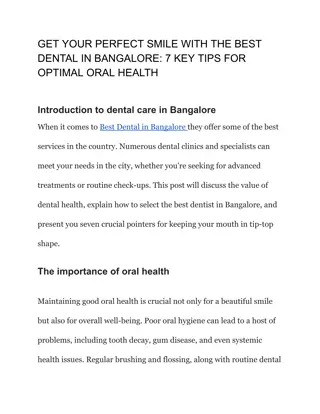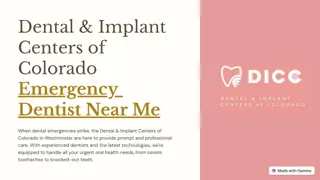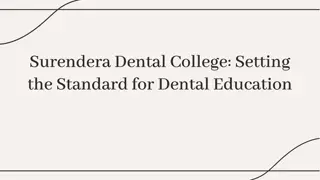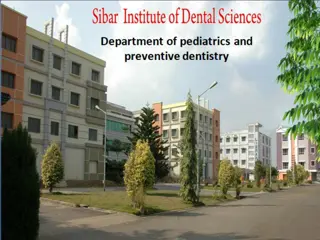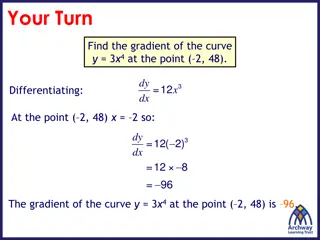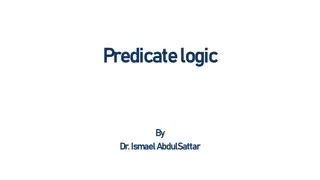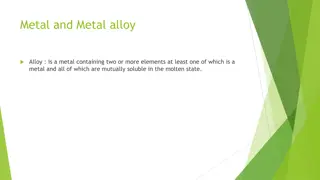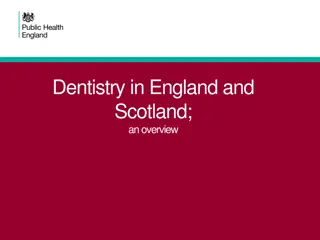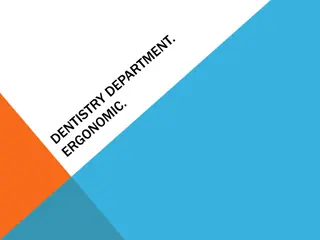Understanding Dental Calculus Formation and Classification
Dental calculus, also known as tartar, is a mineralized bacterial plaque that forms on natural teeth and dental prostheses. It can be classified as supragingival or subgingival based on its relation to the gingival margin. This hard deposit is formed through the mineralization of dental plaque and can vary in composition and formation theories. Learn about the different types, locations, and characteristics of calculus, as well as the factors influencing its initiation and accumulation.
Download Presentation

Please find below an Image/Link to download the presentation.
The content on the website is provided AS IS for your information and personal use only. It may not be sold, licensed, or shared on other websites without obtaining consent from the author. Download presentation by click this link. If you encounter any issues during the download, it is possible that the publisher has removed the file from their server.
E N D
Presentation Transcript
Dental calculus and theories of calculus formation
Learning objectives Definition Classification, composition difference in supra gingival & subgingival calculus Theories of Formation
CALCULUS - Calculus consists of mineralized bacterial plaque that forms on the surfaces of natural teeth and dental prostheses. Calculus is classified as supragingival or Subgingival, according to its relation to the gingival margin. Calculus is a hard deposit that is formed by mineralization of dental plaque on the surfaces of natural teeth and dental prosthesis , generally covered by a layer of unmineralized plaque. CARRANZA 11THED calculus is a hard concretion that forms on teeth or dental prosthesis through calcification of bacterial plaque GLOSSARY OF PERIODONTAL TERMS 2001 , 4TH ED
Tartar Disambiguation Calcis SYNONYMS Odontolithiasis Fossilized plaque
CLASSIFICATION Mainly TWO types: Supragingival Located coronal to calculus: gingival margin Subgingival Located below the calculus crest of the marginal gingiva According to source of mineralization Salivary calculus Serumal calculus (Jenkins, Stewart 1966)
The initiation of calcification and the rate of calculus accumulation vary from person to person for different teeth and at different times of same person According to this they are classified Heavy moderate slight calculus former (Muhlar and Ennever 1962)
SUPRAGINGIVAL CALCULUS Supragingival calculus is located coronal to the gingival margin and therefore is visible in the oral cavity. It is usually white or whitish yellow in color, hard with claylike consistency, and easily detached from the tooth surface. The color is influenced by contact with such substances as tobacco and food pigments.
It may localize on a single tooth or group of teeth, or it may be generalized throughout the mouth. The two most common locations for supragingival calculus to develop are- A- the buccal surfaces of the maxillary molars B- the lingual surfaces of the mandibular anterior teeth.
Other names for supragingival calculus- Supramarginal calculus Extragingival calculus Coronal calculus Salivary calculus
SUBGINGIVAL CALCULUS Subgingival calculus is located below the crest of the marginal gingiva and therefore is not visible on routine clinical examination. The location and extent of Subgingival calculus may be evaluated by careful tactile perception with a delicate dental instrument such as an explorer. Subgingival calculus is typically hard and dense and frequently appears dark brown or greenish black in color while being firmly attached to the tooth surface.
Microscopic studies demonstrate that deposits of subgingival calculus usually extend nearly to the base of periodontal pockets in chronic periodontitis but do not reach the junctional epithelium. Other names for subgingival calculus Submarginal calculus Hematogenentic calculus Serumal calculus
Differences between supra and subgingival Differences between supra and subgingival calculus calculus Supragingival Subgingival Deposits present below the margin margins of the gingiva Color=-brown or greenish-black Source Formed from gingival salivary secretions exudate Conversely less brushite and and octacalcium phosphate more magnesium whitlockite They are absent Sodium content increases with the depth of the pocket Location above the gingival Color white, yellow in color Source derived from salivary secretions exudate Composition more brushite and octacalcium phosphate less magnesium whitlockite Salivary proteins are present Sodium content is lesser
EVALUATION Visual examination by use of compressed air Supragingival calculus is usually recognized by direct vision Small amount of supragingival calculus that have not been stained are frequently invisible when they are wet with saliva. Subgingival calculus deposits can sometimes be detected visually by blowing air down the gingival crevice. Dark edge of calculus may be seen at or just beneath the gingival margin due to its dark color that shine from through the thin gingival margin.
Probing A periodontal probe is needed that can be adapted close to the root surface all the way to the bottom of a pocket. While probing for a rough subgingival tooth surface can be felt when calculus is present.
Radiographs: The deposits may also be visible on radiographs although this is not always reliable. Clinical records: There are various indices for recording and scoring calculus.
It consists of inorganic and organic components Inorganic Content. 70-90 Component percent) Dry weight (in Calcium 27-29 Phosphorus 16-18 Carbonate 2-3 COMPOSITION Sodium 1.5-2.5 Magnesium 0.6-0.8 Fluoride 0.003-0.04 Crystal forms Hydroxyapatite 58 Magnesium whitlockite 21 Octacalcium phosphate 12 Brushite 9
: Organic components Component percent) 1 Mixture of protein, polysaccharide 1.9-9.1 desquamated epithelial cells, leukocytes and various microorganisms. Carbohydrate (consists of glucose, galactose, rhamnose, mannose) 2 Proteins 3 Lipids 0.2 In form of neutral fats, free Fatty acids, cholesterol, phosholipids Dry weight (in 5.9-8.2
The percentage of gram positive and negative filamentous organisms is greater within calculus than in remainder of oral cavity The microorganisms at the periphery are predominantly gram negative rods and cocci Most of the organisms within calculus is non viable Bacterial content
SUPRAGINGIVAL CALCULUS Predominance of gram positive filaments Next- gram negative filaments and cocci SUBGINGIVAL CALCULUS 'superficial layer- gram negative filaments most numerous Deep and middle zones gram positive filaments predominant
Four types of attachment of calculus to tooth surface have been reported. 1. Attachment by means of an organic pellicle. Attachment to the Tooth Surface 2. Mechanical interlocking into surface irregularities such as resorption lacunae and caries. 3. Penetration of calculus bacteria into cementum. 4. Close adaptation of calculus under surface depressions to the gently sloping mounds of the unaltered cementum surface. Calculus when embedded deeply in cementum may appear similar in morphology and thus has been termed as calculocementum.
Formation of Calculus Calculus is a dental plaque that has undergone mineralization. Calculus is formed by the precipitation of mineral salts, which can start between 1st and 14th day of plaque formation. In two days plaque can be 50 percent mineralized and 60 to 90 percent gets mineralized in 12 days.
Calcification starts in separate foci on the inner surface of the plaque. These foci of mineralization gradually increase in size and coalesce to form a solid mass of calculus. Calculus formation continues until it reaches maximum levels in about 10 weeks and 6 months, after which there is a decline in its formation, due to mechanical wear from food and from the lips, cheeks and tongue. This decline is referred to as reversal phenomenon
Calculus is dental plaque which has undergone mineralization. Calculus formation occurs in three basic steps: Pellicle formation All surfaces of the oral cavity are coated with a pellicle. Following tooth eruption or a dental prophylaxis, a thin, saliva- derived layer, called the acquired pellicle, covers the tooth surface.
Initial adhesion and attachment of bacteria Transport to the surface - involves the initial transport of the bacterium to the tooth surface. Initial adhesion - reversible adhesion of the bacterium, initiated by the interaction between the bacterium and the surface, through long- range and short-range forces Attachment - a firm anchorage between bacterium and surface will be established by specific interactions. Attachment - a firm anchorage between bacterium and surface will be established by specific interactions.
Colonization and Plaque Maturation - when the firmly attached microorganisms start growing and the newly formed bacterial clusters remain attached, microcolonies or a biofilm can develop.
Mineralization : rate of formation and accumulation Formation of plaque consist of amorphous and/ or finely granular organic matrix containing mass of variety of gram positive and gram negative coccoid bacteria and filamentous form
1.Booster mechanism 2. bacteriological theory THEORIES OF CALCULUS FORMATION 3.inhibition theory 4.transformation theory 5. epitactic concept 6.enzymatic theory
BOOSTER MECHANISM Mineral precipitation results from a local rise in the degree of saturation of calcium and phosphate ions A rise in the pH of the saliva causes the precipitation of calcium phosphate salts by lowering the precipitation constant Colloidal proteins in saliva bind calcium and phosphate ions and maintain a supersaturated solution with respect to calcium phosphate salts. Phosphatase liberated from dental plaque, desquamated epithelial cells, or bacteria precipitates calcium phosphate by hydrolyzing organic phosphates in saliva, thereby increasing the concentration of free phosphate ions.
BACTERIOLOGICAL THEORY Oral microorganisms are the primary cause of calculus formaton Involved in the attachment to the tooth surface. Leptotrichia and Actinomyces have been considered most often as the causative microorganism.
INHIBITION THEORY Calcification at specific sites - because of inhibiting mechanism at non-calcifying sites. The site where calcification occur the inhibitor is apparently altered or Removed Alkaline pyrophosphatase enzyme involved in controlling mechanism-hydrolyzes pyrophosphate to phosphate (Russell and Fleisch 1970). Pyrophosphate inhibits calcification - prevents the initial nucleus from growing, possibly by poisoning the growth centers of the crystals
TRANSFORMATION THEORY Hypothesis - hydroxyapatite need not arise exclusively via epitaxis or nucleation. Amorphous non-crystalline deposits and brushite Transformed into octacalcium phosphate and then to hydroxyapatite (Eanes et al 1970). Controlling mechanism in transformation mechanism can be pyrophosphate (Fleisch et al 1968).
EPITACTIC CONCEPT / SEEDING THEORY/HETEROGENOUS NUCLEATION (Mandel 1957) According to this concept, seeding agents induce small foci of calcification which enlarge and coalesce to form a calcified mass. The seeding agent in calculus formation are not known, but it is suspected that the intercellular marix of plaque plays an active role. The carbohydrate protein complexes may initiate calcification by removing calcium from the saliva(chelation) and binding with it to form nuclei that induce subsequent deposition of minerals.
Enzymatic theory Calculus formation is the resultant of the action of phosphatases derived from either oral tissues or oral microorganism on some salivary phosphate containing complex,most probably phospheric esters of the hexophosphoric group. (Adamson.KT 1929)






